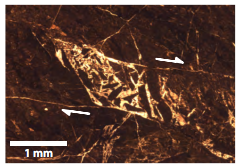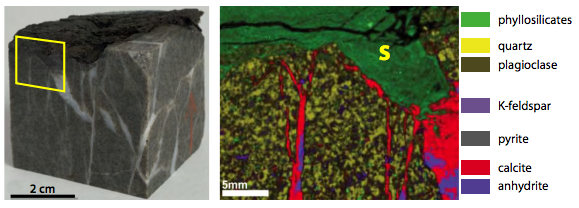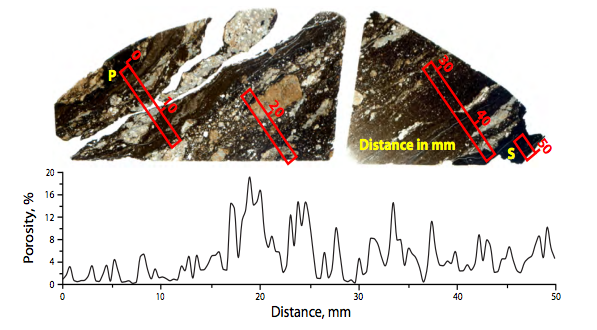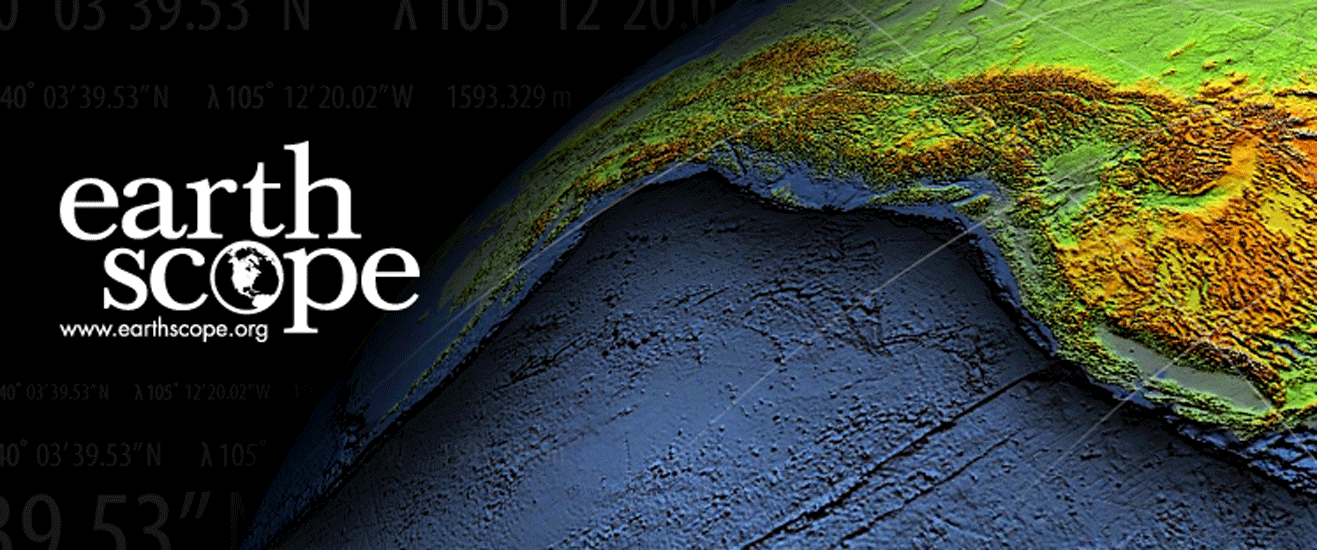By Jafar Hadizadeh, Silvia Mittempergher, Guilio Di Toro, Jean-Pierre Gratier, Julie Richard, and Hassan Babaie - Summer 2011
The San Andreas Fault (SAF) deforms by permanent creep and microseismicity in central California. Higher-thanhydrostatic fluid pressures, which could explain low strength and creep, were not detected during the San Andreas Fault Observatory at Depth (SAFOD) drilling. Instead, aseismic creep is likely due to velocity-strengthening behavior of an intrinsically weak fault gouge in the active shear zones encountered by SAFOD. Creep of low-strength material, though, does not explain the observed repeating microearthquakes.
It has been suggested that repeated slip on hard (friction coefficient µ>0.2) asperity patches of ~15-20 m radius controls seismic failure along the creeping SAF. Seismic inversion reveals such asperities in roughly strike-parallel clusters that make up 1% or less of the total SAF fault surface area. The asperities are surrounded by weak (µ<0.2) velocity strengthening gouge. Based on microstructural evidence, we suggest that the asperity patches responsible for microseismicity are generated by cycles of crack sealing via intergranular pressure solution (IPS) creep in the SAF damage zone.

Whether structural geologists can use fault rock microstructures to identify seismic deformation has been debated since the 1970s. Direct evidence comes only from pseudotachylytes (solidified frictional melt). For other microstructures syntectonic formation has been difficult to establish. Syntectonic formation, however, is likely for microstructures observed in core samples from SAFOD lateral drill holes that were taken less than 100 m from a known cluster of repeating microearthquakes.
We present microstructural and analytical data from samples in the measured depth (MD) interval of 3188 m to 3194 m, only 2-3 m outside of an actively creeping shear zone. The samples show evidence of high fluid pressures (Figures 1 and 2) which provide a weakening mechanism to initiate seismic slip. For a dilation jog to remain open, fluid pressure in the jog must at least equal the lithostatic (overburden) pressure.

We argue that the observed microstructures result from earthquakes that originate in the damage zone rather than in the actively creeping zone because the latter lacks vein networks and mainly consists of almost cohensionless phyllonitic gouge. To relate microstructures to microearthquakes we ask: Are high fluid pressure events episodic? And what are possible controlling mechanisms for seismic failure?

Reworked dilation jogs support episodic fluid pressure events. The dilation jog in Figure 3 has been stretched and fractured by a combination of IPS and cataclastic flow (distributed fracturing), which have been identified as interseismic creep deformation mechanisms based on other SAFOD core sample studies. We discuss two mechanisms for developing asperity patches, noting that local fluid pressure that exceeds hydrostatic pressure is a mechanical requirement for seismic slip on a velocity weakening patch within an otherwise velocity strengthening fault zone.

Fluid pressure build-up requires flow to the site of seismic failure. The SAF, like many other mature fault zones, acts as a hydrologic barrier limiting flow across the fault zone. Fluids primarily flow along-strike and up-and-down dip. Porosity measurements (Figure 4) from clay gouge show that fluid flow through the foliated fault rock may not occur smoothly. The local variations in porosity across the foliation indicate a strong likelihood of local sealing and build up of high fluid pressures in the creeping clay gouge. As IPS dissolves hard minerals like quartz and feldspar at impingement points, the insoluble residues such as clay minerals accumulate at a right angle to the normal stress acting across the fault. The soluble products such as calcite often precipitate and seal off nearby transgranular cracks parallel to the normal stress. This process results in a banding fabric with a highly variable porosity and permeability distribution. The distance dissolved material travels from dissolution to precipitation site (diffusion distance d ) determines the rate of deformation by IPS. For d close to the average transgranular crack length (~10 – 100 μm), steadystate aseismic pressure solution creep could accommodate the entire SAF creep rate of ~20 mm/year (Gratier et al., 2009; Richard et al., 2010). Uneven porosity and permeability could cause extensive crack sealing, locally impeding the solute diffusion (at d >100 μm) so that stresses do not relax. Such local gouge restrengthening may cause microseismicity. The possibility of rupture assisted by transient high fluid pressures in the damage zone is also supported by evidence of anhydrite and calcite vein sealing found in the same injection event (Figure 2), suggesting a breach of barriers between isolated fluid sources.
An alternative explanation involves the spatial distribution of material contrasts within the damage zone. The two active creep zones in the SAFOD main hole are ~100 m apart and are expected to vary in width and spacing with a tendency to pinch, branch, and converge along strike within the damage zone. Field evidence and modeling suggest that undulations of the embedded active zones could result in a non-uniform stress distribution and pore pressure buildup in structural boundary regions resulting in microseismicity.
The evidence of extensive IPS in the SAF damage zone and the possible role of pressure solution creep in generating microseismicity are exciting new findings. This microstructural study serves to constrain parameters and state variables of mechanical models of faulting. The complexity and variety of structural deformation prompt us to emphasize that a significant amount of microstructural information remains to be extracted from the SAFOD cores and to be integrated in the development of more realistic deformation models for the SAF. Core and cuttings samples from SAFOD drilling have provided the Earth science community with unique opportunities for firsthand, direct observations of an active plate boundary fault.
References
Gratier, J-P., Richard, R., Mittempergher, S., Renard, F., Doan, M., Di Toro, G., Hadizadeh, J., Boullier-Bertrand, A. M., 2009. Pressure solution as a mechanism of creep and sealing in active faults: Evidence from the SAFOD samples. Eos Trans. AGU 90(52), Abstr. T21B-1795.
Mittempergher, S., Di Toro, G., Gratier, J-P., Hadizadeh, J., Smith, S. A., Spiess, R., 2011. Evidence of transient increases of fluid pressure in SAFOD phase III cores. Geophys. Res. Lett. 38, L03301.
Richard, J., Gratier, J-P., Renard, F., Mittempergher, S., Doan, M., di Toro, G., Hadizadeh, J., Boullier-Bertrand, A., 2010. Pressure solution creep as a mechanism of aseismic sliding in active faults: evidence from the San Andreas Fault Observatory at Depth (SAFOD). Eos Trans. AGU 91 (52), Abstr. T41A-2106.





